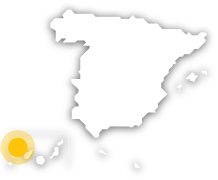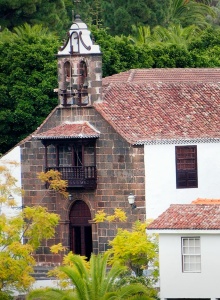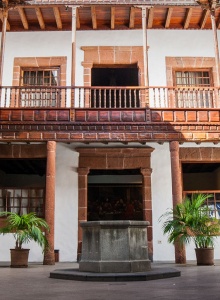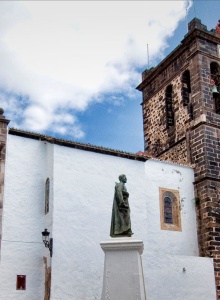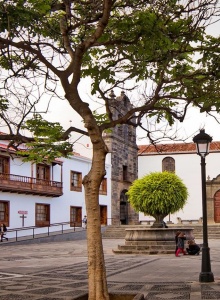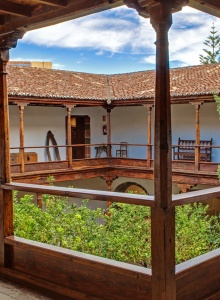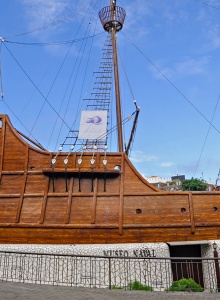A small but beautiful city, with a maritime flavour. Going for a walk here, by day or by night, is a sensation-filled experience. It is a place steeped in history.
Santa Cruz de La Palma is a beautiful colonial-style city whose historic quarter, declared a Historic-Artistic Site, boasts many palaces, colonial-style buildings and houses bearing typical elements of traditional Canary Islands architecture. Other interesting places include churches and the Shrine of Virgen de las Nieves, where a centuries-old tradition takes place: the Descent of the Virgin of Las Nieves, the patron saint of the island.
The history of Santa Cruz de La Palma begins at the end of the 15th century, when Alonso Fernández de Lugo conquered the island for the Crown of Castile. From that point on, the city began to acquire substantial economic power.
Its importance on the trade routes to Europe –and particularly to the Americas– was so great that in 1558 it became the home of the first Courts and Assizes of the Indies. The city had become a flourishing export hub, and attracted large numbers of merchants and bankers. All this, in combination with the intense naval activity undertaken by its shipyards, served to make Santa Cruz de La Palma the third most important maritime port in the Spanish Empire, after Seville and Antwerp.
The cityThis glorious past can still be seen in the historic centre of Santa Cruz de La Palma in the priceless legacy of palaces, colonial-style buildings and houses bearing typical elements of traditional Canary Islands architecture such as the wooden balconies.
In this small but charming city, declared both a Property of Cultural Interest and a Historic-Artistic Site, the emblematic Calle Real stands out. Calle Real is the city's main street, mostly cobbled, where the main shops, squares, large houses and interesting buildings can be found. A lazy stroll here is a good way to enjoy the city. From north to south, visitors can learn about the capital's traditions, history and culture.
The Plaza de España is a meeting point for the locals, and the place where some of the island’s most important buildings are to be found. Here you’ll find the City Council Building, the Church of El Salvador, and a very unusual fountain at one end of the square. It is worth noting that it is a ensemble of Renaissance buildings unique in the archipelago.
Placeta del Borrero is a small secluded square surrounded by houses in typical Canarian style. A perfect place to take a break and enjoy a barraquito, a traditional coffee made with condensed milk, liqueur and cinnamon served with a slice of lemon, or a craft beer. The Plaza de la Alameda is located in the northernmost part of the capital. It is a long square with the Naval Museum at one end, and the statue of the "dwarf".
At this point, the visitor can cross the bridge to climb up to the Castillo de La Virgen, located at the other end of the ravine. The views of the city from here are amazing. Nearby stands the church of La Encarnación, graced by La Anunciación, a polychromed wooden sculpture dating from the 16th century.
Next, one option is to head back to your starting point via Avenida Marítima, enjoying the sea breeze along the way. The first stop is the walls of the Castle of Santa Catalina, a military fortification that helped to defend the city from the pirates and corsairs in the 16th and 17th centuries.
The second stop is the balconies on Avenida Marítima. They are typical Canarian houses with wooden balconies that are beautifully decorated with brightly coloured flowers.
On a visit to the capital, a pleasant stroll down Calle de San Sebastián with its traditional atmosphere is a must. Also worth exploring is the area around the church of Santo Domingo, the Circo de Marte theatre and the Virgen de la Luz chapel. The latter affords spectacular views of the port.
Gastronomy, festivities and the surrounding areaSanta Cruz de La Palma offers the chance to discover all the most representative dishes of the island gastronomy. The best options include papas arrugás con mojo (tiny potatoes boiled in their skin with lots of salt) accompanied by red or green mojo (typical sauce of the Canary Islands), pork or fish, potaje (a hearty soup) and bienmesabe for dessert (a sweet made from egg yolks, ground almonds, sugar, etc.), all washed down with La Palma Designation of Origin wine.
There are many hotels, apartments, guesthouses and country house lodges which will make your stay enjoyable.
The local inhabitants of La Palma – like the rest of the Canary Islanders– are friendly and fun-loving, as can be seen from their festivities. The Bajada de la Virgen de las Nieves is an event celebrated every five years, and one of the main attractions is the Dance of the Dwarves. There are also other traditions: Minué, Carro Alegórico, the dialogue between the Ship and the Castle, etc. Two weeks of festivities, Chica and Grande, at the beginning of July, should not be missed.
But Los Indianos, held on the Monday of Carnival week, is the festival is the capital’s most characteristic festival. Talcum powder, white clothing and straw hats turn the city streets white.
On the night of the 2nd and the early hours of the morning of 3rd May, the crosses in the capital are adorned for the Festival of the Crosses, accompanied by the interesting mayos, which are dolls made out of cloth that represent everyday scenes or famous people.
La Palma offers a multitude of hiking options. Santa Cruz de La Palma has many paths that take you straight to the countryside after a few kilometres: Barranco de la Madera ravine or Molinos de Bellido mills are some of the options.

